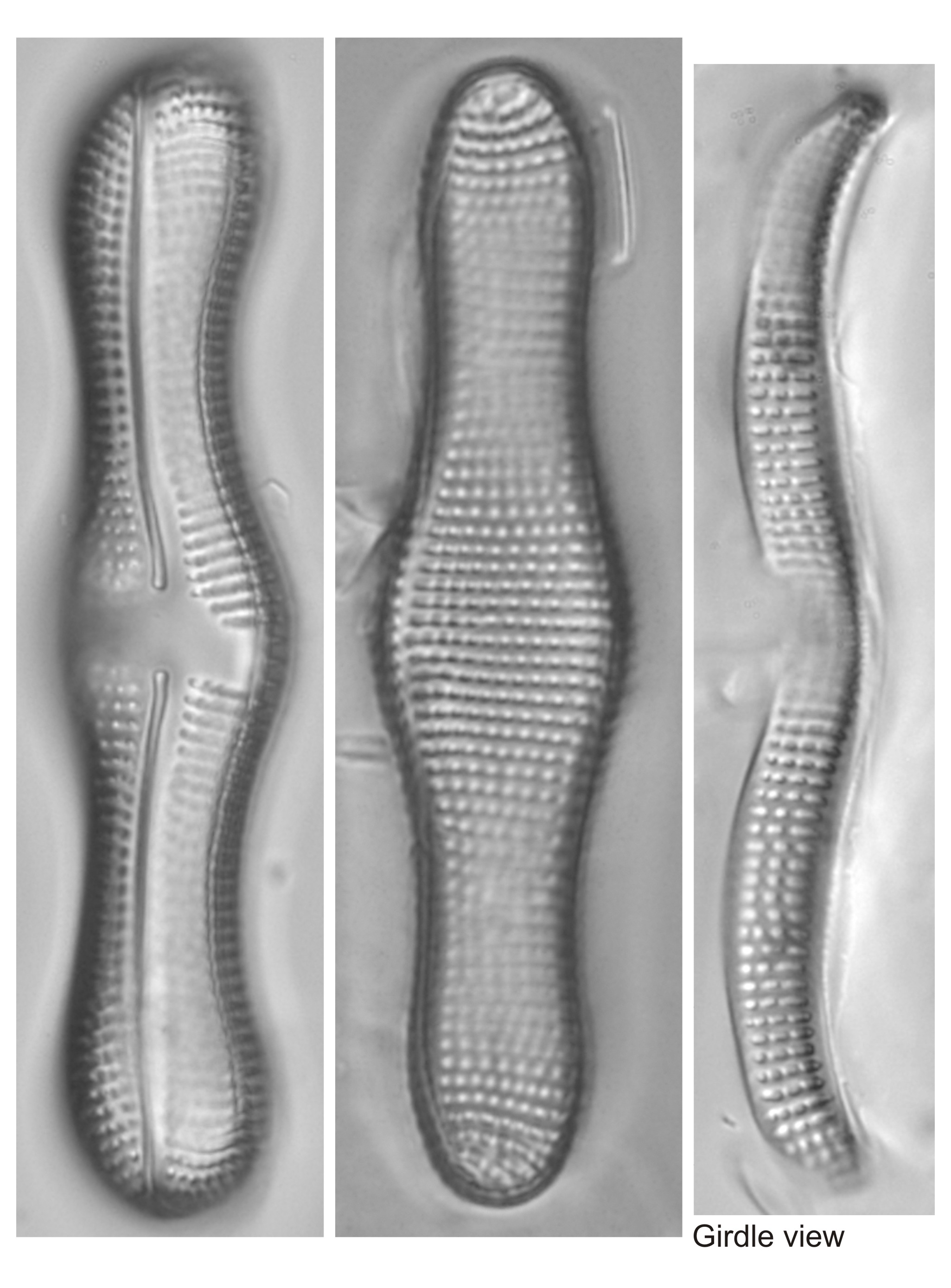Achnanthes Bory; 1822; 79, 593
Key references
Toyoda K., Cox E.J., Sims P.A., Williams D.M. 2005. The typification of Achnanthes Bory based on Echinella stipitata Lyngbye, with an account of the morphology and fine structure of Lyngbye's species. Diatom Research. 20(2): 375-386.
Morphology
Cells elliptical, linear, lanceolate, or with undulate margins in valve view, with rounded, cuneate or protracted apices; frustules bent about the transapical axis to form a shallow 'v' in girdle view, apices sometimes reflexed. Girdle deep or moderately deep, so that cells lie either in valve or girdle view.
Frustules heterovalvar with a concave raphe valve and a convex rapheless (pseudoraphe) valve; isopolar and bilaterally symmetrical in outline, but the rapheless valve generally has an asymmetrical pattern and structure.
Striae uni-, bi- or triseriate, similar in structure on both valves, but sometimes differing in orientation; areolae occluded by complex cribra.
Axial area narrow, straight or slightly curved; central area variable, sometimes a narrow or broad rectangular fascia or stauros. Sternum (pseudoraphe) on the rapheless valve uniformly narrow, never expanded centrally, sometimes clearly displaced towards the valve margin.
Cells of freshwater and subaerial species solitary, occasionally forming short chains; some marine species colonial, forming linear chains. Attached directly to a surface by one valve face, or by a mucilage pad or stalk secreted from the raphe at one valve apex.
Two H-shaped chloroplasts positioned ‘fore and aft’ in the cell (i.e. one towards each apex), each consisting of two girdle-appressed plates linked by a wide bridge containing the pyrenoid; or (in some marine species) many small plastids.
Frustules heterovalvar with a concave raphe valve and a convex rapheless (pseudoraphe) valve; isopolar and bilaterally symmetrical in outline, but the rapheless valve generally has an asymmetrical pattern and structure.
Striae uni-, bi- or triseriate, similar in structure on both valves, but sometimes differing in orientation; areolae occluded by complex cribra.
Axial area narrow, straight or slightly curved; central area variable, sometimes a narrow or broad rectangular fascia or stauros. Sternum (pseudoraphe) on the rapheless valve uniformly narrow, never expanded centrally, sometimes clearly displaced towards the valve margin.
Cells of freshwater and subaerial species solitary, occasionally forming short chains; some marine species colonial, forming linear chains. Attached directly to a surface by one valve face, or by a mucilage pad or stalk secreted from the raphe at one valve apex.
Two H-shaped chloroplasts positioned ‘fore and aft’ in the cell (i.e. one towards each apex), each consisting of two girdle-appressed plates linked by a wide bridge containing the pyrenoid; or (in some marine species) many small plastids.
Literature
References are given in chronological order.
Reference |
Citation |
|---|---|
| Bory de Saint-Vincent J.B.M. 1822. Collaborator in Dictionnaire Classique d'Histoire Naturelle. 1. Rey & Gravier, libraires-éditeurs; Baudouin Frères, libraires-éditeurs, Paris. 79-80, 593 pp | Morphology; Description |
| Lange-Bertalot H., Krammer K. 1989. Achnanthes eine Monographie der Gattung mit Definition der Gattung Cocconeis und Nachträgen zu den Naviculaceae. Bibliotheca Diatomologica Vol. 18. 393 pp; 100 pls | Morphology; Illustrations |
| Toyoda K., Nagumo T., Osada K., Tanaka J. 2003. Morphological investigations of Achnanthes javanica Grunow and A. subconstricta (Meister) comb. nov. Diatom Research. 18(2): 365-375. | Morphology; Illustrations; Taxonomy |
| Toyoda K., Williams D.M. 2004. Description of Achnanthes Bory (Bacillariophyceae) based on Kützing's type slides and materials I: New morphological information on Achnanthes brevipes var. intermedia (Kütz.) Cleve. Diatom. 20: 159-165. | Morphology; Description; Type Illustration |
| Toyoda K., Cox E.J., Sims P.A., Williams D.M. 2005. The typification of Achnanthes Bory based on Echinella stipitata Lyngbye, with an account of the morphology and fine structure of Lyngbye's species. Diatom Research. 20(2): 375-386. | Morphology; Taxonomy; Type Illustration; |
| Cox E.J. 2006. Achnanthes sensu stricto belongs with genera of the Mastogloiales rather than with other monoraphid diatoms(Bacillariophyta). European Journal of Phycology. 41: 67-81. | Morphology; Taxonomy; Illustrations |
| Lowe R.L., Sherwood A.R., Ress J.A. 2009. Freshwater species of Achnanthes Bory from Hawaii. Diatom Research. 24(2): 327-340. | Morphology; Illustrations; Ecology |
| Tofilovska S., Wetzel C.E., Ector L., Levkov, Z. 2014. Observation on Achnanthes Bory sensu stricto (Bacillariophyceae) from subaerial habitats in Macedonia and comparison with the type material of A. coarctata (Brébisson ex W. Smith) Grunow, A. coarctata var. sinaensis Hustedt and A. intermedia Kützing. Fottea. 14(1): 14-42. | Morphology; Illustrations; Type Illustration |
This page should be cited as:
Mann D. G., Kelly M., Jüttner I. Achnanthes Bory; 1822; 79, 593. In: Jüttner I., Carter C., Cox E.J., Ector L., Jones V., Kelly M.G., Kennedy B., Mann D.G., Turner J. A., Van de Vijver B., Wetzel C.E., Williams D.M..
Freshwater Diatom Flora of Britain and Ireland. Amgueddfa Cymru - National Museum Wales. Available online at https://naturalhistory.museumwales.ac.uk/diatoms/browsespecies.php?-recid=3595. [Accessed:
].
Record last modified: 27/12/2020


